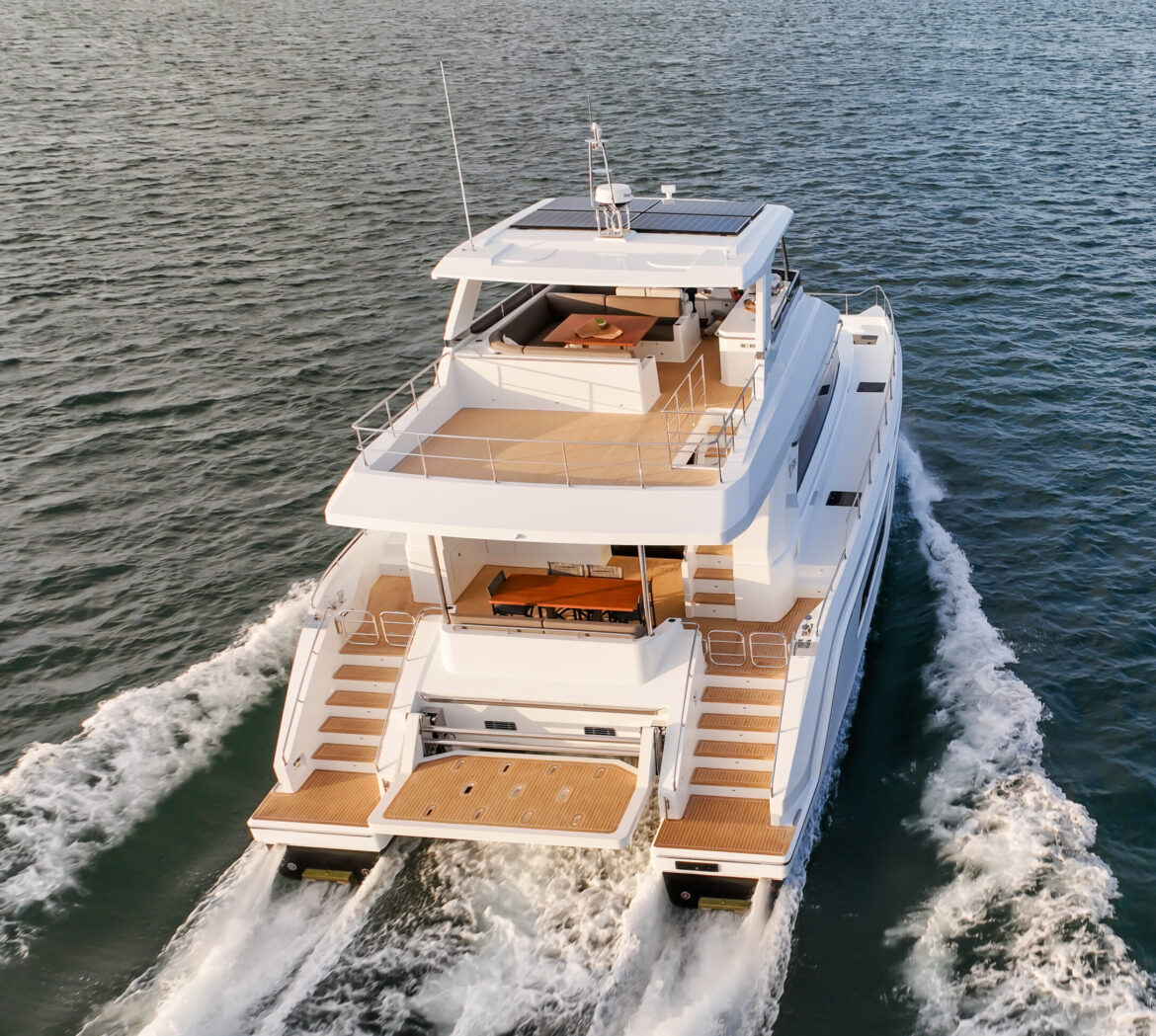A Trojan Horse with more than meets the eye
According to the Google bible, The Iliad is one of two major ancient Greek epic poems attributed to Homer. It is one of the oldest extant works of literature still widely read by modern audiences. The Iliad recounts a brief but crucial period of the Trojan War, a conflict between the city of Troy and its allies against a confederation of Greek cities, collectively known as the Achaeans. The Iliad means ”poem of Troy”. The Greek epic is exactly that: a long poetic account of the Greek siege of the city of Troy.
So why does this range of vessels, ILIAD Catamarans, owe its name to such a classic poem? Kate Elkington, Business Development and Marketing Manager for the brand, set me straight. “Homer’s ships are legendary for their long-range capabilities and commanding performance, and this resonated with us as, in addition to luxury and quality, these are some of the defining features of our range of catamarans.” Nicely done.
But I find myself in the strange situation of being on a vessel that I am not typically drawn to, in fact, I am not sure I have ever stood on a multihull before. The traditional catamaran captain of old was for me, one of those middle-aged, passionate, beige Volvo drivers at the dinner table who did a little too much research and bored you to tears with their rhetoric. Very earnest folk, a bit like in the modern world of getting a Tesla owner started on the benefits of their EV compared to others. But times have moved on. I am now a middle-aged Tesla owner and it seems, at first glance, that the catamaran builds and use of economies of space are fabulously innovative and exciting to talk about.
I meet up with senior sales executive Marcus Overman sometime before “sparrows” at The Boat Works, a droolworthy spot for boaties in the upper reaches of the Coomera River. A place that boasts every sort of vessel sales office you can imagine, so it’s pretty hard for a vessel to stand out among the crowd. But the ILIAD 53F did, in fact, by and large head and shoulders above its cohorts.
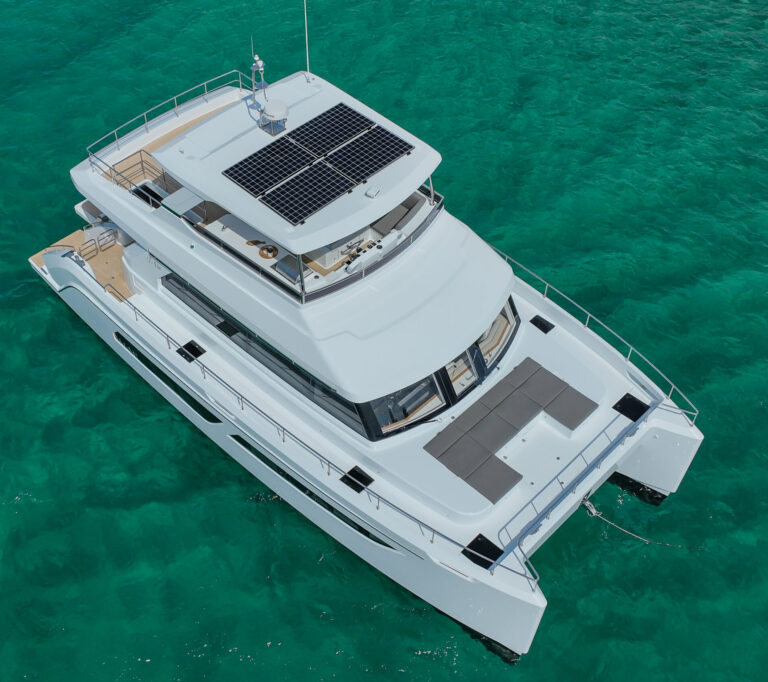
THE SALOON
The numbers on this boat are massive – with a length of a little over 16 metres and a beam of a nudge under 8 metres. That is of course your saloon, cockpit and foredeck taken care of which literally equates to the space of some 22-metre boats I have seen in terms of communal space. A lot is going on in the saloon with a massive full-sized kitchen with clean lines and very chef-friendly. The whole area was serviced by double doors aft and fold-back windows which opened the back up nicely, and one forward midships window for cross breeze. Apart from the large kitchen, there is a plethora of soft sofas and seats with upholstery crafted in synthetic Ultraleather, fabulous to the touch. It seems like under every recess and height change there is fabulously super hidden strip lighting which gives the whole space a golden glow, a real credit to the lighting architect. The lower helm is to the starboard side which normally has a double seat with a bolster, while our ride had optioned in a single helm chair. This cleverly swung around to the starboard side when at anchor or when time allowed and became an office chair with a desk set up beside it. There are quite a number of hidden power points, hatches and hideyholes, too many to list, but suffice to say you could never complain about storage in the saloon itself.
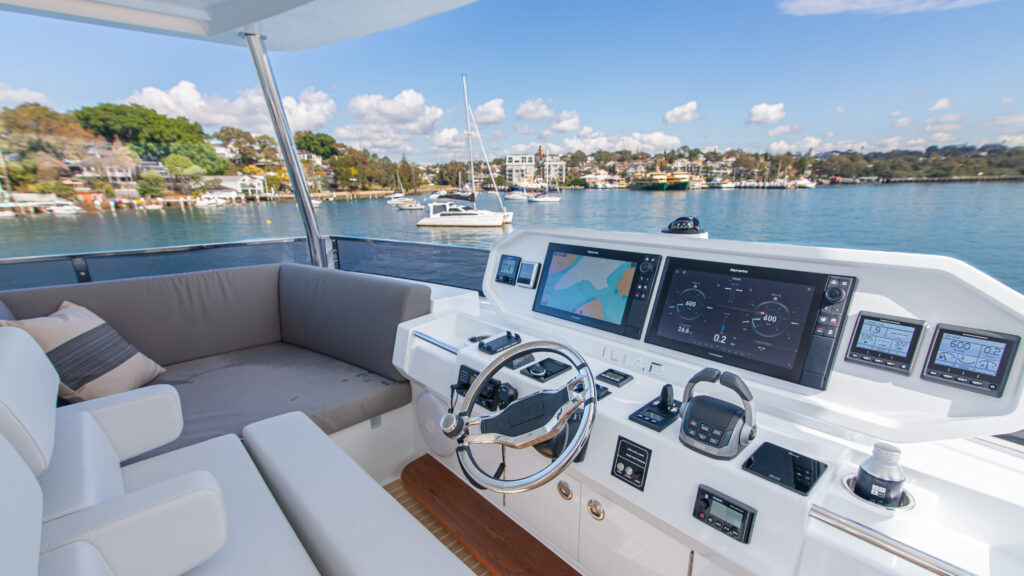
ACCOMMODATIONS
On either side of the saloon are stairs down into the two hulls. You have to keep reminding yourself you are on a catamaran and not a monohull. As you go down, and further down into the starboard hull, you are presented with an athwartships owner’s cabin around the midship of the hull that can either be a full king or queen. There are oodles of light thanks to the hull windows and tinted deck hatches. There’s also a full ensuite bathroom and the cabin has a nicely placed chair to curl up on in the sun as well as a vanity table and shelving.
This is also a haven for escape from the guests as unlike typical vessels you have the hull to yourself, no sharing the hallway. Across to the other hull and once again down, and further down the stairway, you find yourself with two guest cabins each with their own ensuites. The forward cabin is full of beds, one single and a double. I would suggest this as a room for the kids or a couple and a little one. The aft cabin has a choice of layouts from double to king or as with this one, two singles with an optional infill to make a large king-size bed.
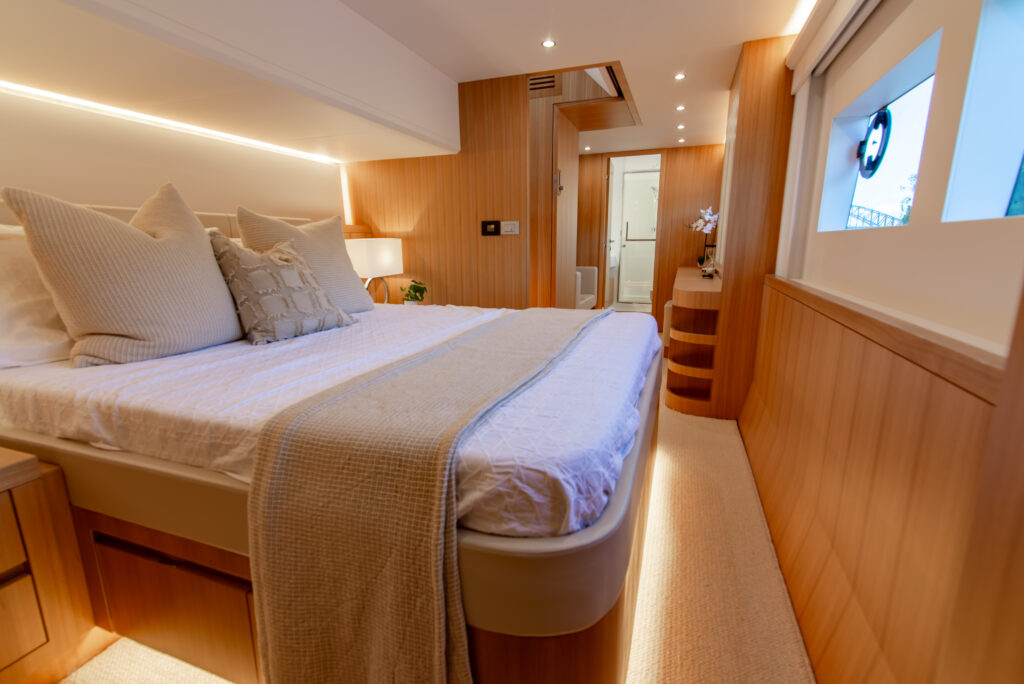
COCKPIT AND SEA ACCESS
The hardwood floor of the saloon seamlessly flows out to the teak cockpit where you find a full-sized dining table. This is a huge, uncluttered area with the deck walkways on either side being once again of generous proportions as well as the easy-to-navigate sweeping staircase to the bridge. The teak doesn’t stop there it continues down the stairs to a duckboard of sorts which is replicated on both hulls. The movable boarding platform or duckboard sits noticeably higher than the other two hulls suspended from what you would call the midships transom except the transom doesn’t go all the way to the waterline. And because it pushes out seaward and then lowers down, this means there are no restrictions on the length of any tender. As long as it draws less than a metre and weighs south of 450 kilograms it can be accommodated.
ENGINES
With one relatively small 550 hp Volvo engine per engine room per hull, and just the one Onan 13.5 KW generator fitted on the port side, these engine rooms are large. They are beautifully uncomplicated spaces that are obviously designed for long-range cruising and engine first aid if required, judging by the access you have around the machinery. An engine room is not a place that I am all that comfortable with and most times I simply close the door, throw my hands up in the air and admit I know less when I get in there than before I entered. But the way this machinery space is laid out gave me a bit of satisfaction as even I could follow cables and pipes to sort out what’s what if needed.

FROM THE SALES DEPARTMENT
Marcus talks me through what he sees as the distinct advantages of cats over monohulls. “This vessel has arguably the space of a 60–65-foot vessel and instead of being pushed along by 1000–1200 horsepower per side, we are using 550 HP per side” he explains.
“Another advantage is the owner’s cabin being in its own distinct hull away from other guests. Then there is the class-leading range, of course, and the natural stability, which means you don’t have to run stabilisers or gyros at night, meaning no generators are needed at anchor. And with this vessel, it’s more about the journey with a top speed of mid-20 knots with a cruise in the late teens around 18 knots. You can also carry two tenders, one on the aft deck and one on the top deck, which for a 53-foot vessel is a lot of toys. And finally, it has a shallow draft which means you can get further up into bays and inlets to avoid the weather.”
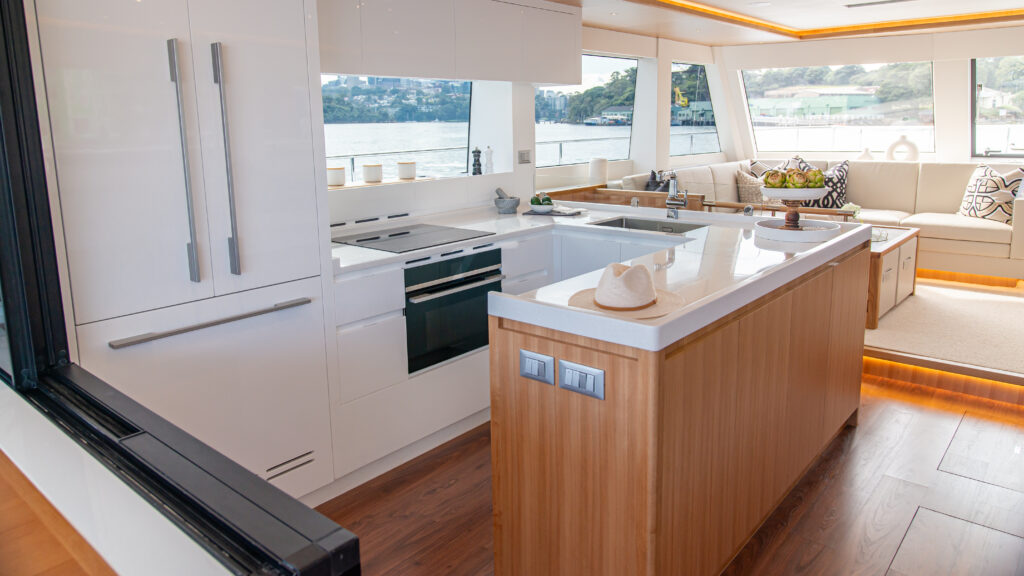
BRIDGE
Accessed by the full-width staircase you are led up to the bridge and are met with a huge outdoor area, with a couple of removable chocks to house a tender or a 12-seat dining table. Further forward on the port side is the built-in seating for around 10 folks with a retractable dining table to fit all your guests in with comfort. The starboard houses a barbeque and everything else, including the kitchen sink. Then there is the helm seat, an oversized adjustable bolster sit/stand seat that has room for another few navigators on your port side. The helm station itself works off a couple of Raymarine 16-inch displays, almost mirroring the downstairs helm in terms of tech.
DECKS
The side gunwales are wide and generous although potted with a few tinted skylights to let light into the hulls. My natural tendency was to avoid walking directly on them, but I also avoid cracks in the pavement, and when tested there was minimal bounce or give on the skylights. Up forward, as well as a fabulous and generously proportioned place to rest, the boat had a few more tricks up her sleeve or more to the point in her hull. Surprise number one was looking into the midships forward storage lockers and anchor space. They are huge and deep. I reckon there was room for a half dozen fenders at least in there and not the skinny little ones. Rather the big fat ones that new boaties furnish the rails with, in order to bounce off the pier. Surprise number two came in the form of what I would term the “focsle” or forecastle of the hulls. These things are huge in terms of head height and length and, as it turns out according to Marcus, “can be fitted into crew quarters for charter vessels”.
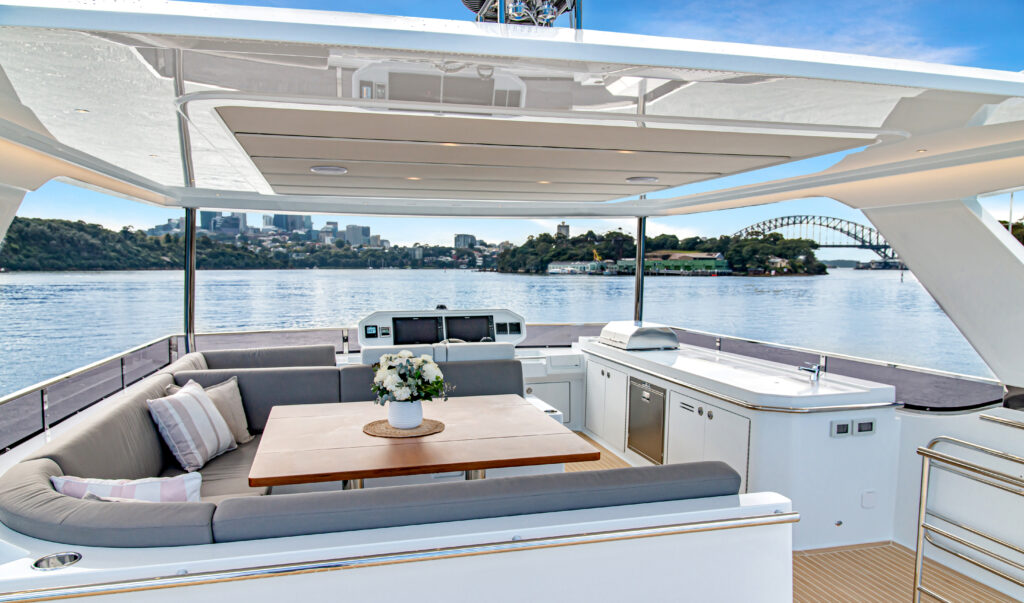
WHY BUY?
This is the second multihull bought by the owners of this vessel with the first being an ILIAD 50, the predecessor to the 53 Series. “We choose multihulls because they are such a stable platform at rest and yet still a very good boat at sea. We also like the ability to turn off generators and run the whole boat on solar power and lithium house batteries. A wide beam and flybridge enables the installation of a sizeable solar array that can legitimately run all house power needs outside of the air-conditioner and BBQ. So complete peace and quiet for us at rest but also as a means of reducing fuel consumption. We enjoy coastal cruising from Sydney to Port Stephens and surrounds with kids, sports and school keeping us ‘anchored’ nearer to Sydney more than we would like”. (Finally) ILIAD Catamarans’ pre-sales, fit, finish and after-sales service really stood out to us. The ability to get involved in the design process and customise the boat to our needs, coupled with the quality branded products installed, gives a high level of confidence that the boat will perform to expectations. The team at ILIAD also really go above and beyond to make the boat ownership experience trouble-free and enjoyable.”

SUMMARY
I am now a catamaran captain convert. These wave runners are an amazing invention and I know they have been around for an age, however, what has been crafted in the ILIAD models in terms of space, fit-out, sound engineering and economy is sensational. The space is absolutely mind-blowing when you consider you are on a 53-foot vessel. The fit-out is right up there with the top longer-established brands with huge amounts of fitted furniture and styles that hold the elegance of the boat together. Even at full throttle in the saloon, all that’s required for communication is a quiet inside voice, so there has obviously been a lot of investment in the sound engineering. Finally, the economy is amazing. A comfortable 1600 nautical miles can be achieved at 8 knots or if you’re in a bit more of a dash you can easily clip along at 18 knots, gobbling 7.5 litres per hour, which would not break the bank.
SPECIFICATIONS
Length 16.37m
Beam 7.63m
Draft at full load 1.25m
Displacement 27,500kg
Range 2,500nm
Fuel Tanks Capacity 3,500L
Water Tanks Capacity 800L



